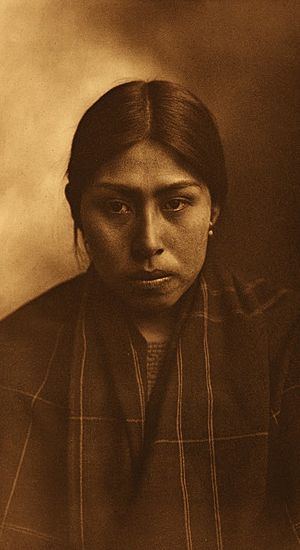Suquamish facts for kids

Suquamish woman photographed by Edward S. Curtis in 1913.
|
|
| Total population | |
|---|---|
| ~6,500 | |
| Regions with significant populations | |
| Languages | |
| English, Lushootseed |
The Suquamish are a Native American people who traditionally speak Lushootseed. They live in what is now Washington in the United States. They are part of the southern Coast Salish people.
Today, most Suquamish people are part of the Suquamish Tribe. This tribe is officially recognized by the U.S. government. In 1855, the Suquamish Tribe signed the Treaty of Point Elliott. Chief Seattle, a famous leader of both the Suquamish and Duwamish Tribes, signed this treaty. The city of Seattle is named after him. The Suquamish Tribe now owns the Port Madison Indian Reservation.
Contents
Suquamish Language
The Suquamish people traditionally spoke a special kind of Lushootseed. This language belongs to the Salishan language family.
Suquamish Culture and Life
Before Europeans arrived, the Suquamish people lived well from the land and sea. They lived west of the Cascade Mountains. They caught salmon and gathered shellfish from local waters and Puget Sound.
The cedar tree was very important to them. They used its fibers to weave waterproof clothes. They also made beautiful and useful items. Cedar wood was used to build longhouses, which were large homes. They also made big canoes for traveling on the sea and special items for ceremonies.
The Suquamish traditionally lived along the western shores of Puget Sound. Their territory stretched from Apple Tree Cove in the north to Gig Harbor in the south. This area included Bainbridge Island and Blake Island. They had many villages. The biggest was Old Man House, which was the largest winter longhouse in the Salish Sea.
Today, the Suquamish still fish and gather food in their traditional lands. New artists, like Ed Carriere, continue to create carved or woven items. These artworks help share the stories of the Suquamish people.
Early History and European Contact
The Suquamish first met Europeans in 1792. This happened when George Vancouver explored Puget Sound. He met members of the Suquamish Tribe, possibly including Schweabe and Kitsap. More regular contact with non-Native people began in the early 1800s. This was when British trading posts were set up in Puget Sound and the Strait of Georgia.
The 19th Century and Treaties
In 1853, the Washington Territory was created. The U.S. government then started signing treaties with Native leaders. These treaties aimed to gain land for non-Native settlers.
On January 22, 1855, the Suquamish signed the Treaty of Point Elliott. In this treaty, the Suquamish agreed to give land to the United States. In return, they received certain payments and promises. They kept some land for themselves, which became the Port Madison Indian Reservation. This reservation is near their old winter village on Agate Pass. They also kept the right to fish and gather shellfish in their usual areas. They also kept certain cultural and natural resource rights within their historical territory. Today, the Suquamish Tribe works with the State of Washington to manage the state's salmon fishing.
Two Suquamish leaders became very well known. One was Kitsap. Around 1825, he led a group of Puget Sound Tribes against the Cowichan Tribes from Vancouver Island. Another famous leader was Seattle. He was the son of Schweabe. Chief Seattle worked for peace during the difficult times of the mid-1800s.
Important Suquamish Leaders
Martha George was the chairwoman of the Suquamish Tribe from the late 1920s to the early 1940s.
Lawrence Webster (1899-1991) was chairman of the Suquamish Tribe from 1979 to 1985. In 1979, he went to Washington, D.C., to represent Native Americans. He helped start the Suquamish Museum in 1983. Earlier in his life, he was a talented baseball catcher. He played on a Suquamish team that toured Japan in 1921.
Leonard Forsman has been the Suquamish Tribe’s chairman since 2005. He is an expert in anthropology and archeology. He has also served on state and national councils.
Cindy Webster-Martinson was a member of the Suquamish Tribal Council. In 2013, she was elected to the North Kitsap School Board. She is believed to be the first Native American elected to a non-Tribal public office in Kitsap County. She is the granddaughter of Lawrence Webster.
How the Suquamish Tribe is Governed
The Suquamish Tribe is led by a seven-member council. Citizens of the Suquamish Tribe elect these council members. The tribal government has many departments. These include administration, education, fisheries, human services, and police.
The Tribe also makes important economic contributions. In 2012, they paid over $52 million in wages to employees. They also bought over $46 million in goods and services. They invested over $18 million in new projects. In the same year, they gave over $694,000 to 201 different organizations.
Recent History and Land
Port Madison Enterprises is the Tribe’s business group. It is one of the largest private employers in Kitsap County. It has 752 employees.
Port Madison Enterprises runs several businesses. These include the Suquamish Clearwater Casino Resort, White Horse Golf Club, and Kiana Lodge. They also have retail stores and property management. The PME Fund uses money from non-gaming businesses to give grants. These grants help improve the lives of community members and support good programs in the region.
The Tribe has been buying back land that was lost a long time ago. The Suquamish Tribe and its members now own more than half of the land on the reservation. This is the first time this has happened in recent history. Important land purchases include White Horse Golf Club in 2010 and 200 acres known as the Place of the Bear in 2014.
As of 2014, the reservation covers 7,657 acres. The Suquamish Tribe owns 1,475 acres. Individual Suquamish citizens own 2,601 acres. Non-Natives own 3,581 acres.
See also
 In Spanish: Suquamish para niños
In Spanish: Suquamish para niños

